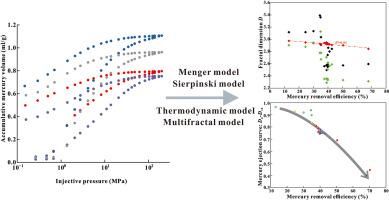Application of fractal model in the Jurassic tight sandstone reservoirs of central Junggar Basin as constrained by mercury ejection curves
IF 3.6
引用次数: 0
Abstract
The high-pressure mercury intrusion (HPMI) experiment is widely used to assess the pore architecture of tight sandstone reservoirs. However, the conventional analysis of the high-pressure mercury intrusion has always focused on the mercury injection curves themselves, neglecting the important geological information conveyed by the mercury ejection curves. This paper quantitatively describes the fractal characteristics of ejection curves by using four fractal models, i.e., Menger model, Thermodynamic model, Sierpinski model, and multi-fractal model. In comparison with mercury injection curves, we explore the fractal significance of mercury ejection curves and define the applicability of different fractal models in characterizing pore architectures. Investigated tight sandstone samples can be divided into four types (Types A, B, C and D) based on porosity, permeability, and mercury removal efficiency. Type D samples are unique in that they have higher permeability (>0.6 mD) but lower mercury removal efficiency (<35%). Fractal studies of the mercury injection curve show that it mainly reflects the pore throat characteristics, while the mercury ejection curve serves to reveal the pore features, and porosity and permeability correlate well with the fractal dimension of the injection curve, while mercury removal efficiency correlates only with the Ds' value of the ejection curve. The studies on the mercury ejection curves also reveal that the small pores and micropores of the Type C and Type D samples are more developed, with varying pore architecture. The fractal dimension DS’ value of Type D samples is greater than that of Type C samples, and the dissolution of Type D samples is more intense than that of Type C samples, which further indicates that the Type D samples are smaller in pore size, rougher in surface, and with greater difficulty for the hydrocarbon to enter, resulting in their reservoir capacity probably less than that of Type C samples. In this regard, the important information characterized by the mercury ejection curve should be considered in evaluating the tight sandstone reservoirs. Finally, the Menger and Thermodynamic models prove to be more suitable for describing the total pore architecture, while the Sierpinski model is better for characterizing the variability of the interconnected pores.

分形模型在含汞曲线约束下准噶尔盆地中部侏罗系致密砂岩储层的应用
高压压汞实验被广泛应用于致密砂岩储层孔隙结构评价。然而,传统的高压压汞分析往往只关注压汞曲线本身,而忽略了压汞曲线所传递的重要地质信息。本文采用Menger模型、热力学模型、Sierpinski模型和多重分形模型四种分形模型定量描述了喷射曲线的分形特征。通过与压汞曲线的对比,探讨了压汞曲线的分形意义,定义了不同分形模型在表征孔隙结构中的适用性。根据孔隙度、渗透率和脱汞效率,将致密砂岩样品分为A、B、C、D四种类型。D型样品的独特之处在于它们具有更高的渗透率(>0.6 mD),但较低的汞去除效率(<35%)。压汞曲线的分形研究表明,压汞曲线主要反映孔喉特征,压汞曲线反映孔隙特征,孔隙度和渗透率与压汞曲线的分形维数有很好的相关性,而脱汞效率仅与压汞曲线的Ds值相关。排汞曲线研究还表明,C型和D型样品的小孔和微孔更为发育,孔隙结构各异。D型样品的分形维数DS值大于C型样品,并且D型样品的溶解作用比C型样品更强烈,这进一步说明D型样品孔径更小,表面更粗糙,油气进入难度更大,其储集能力可能小于C型样品。因此,在评价致密砂岩储层时,应考虑以出汞曲线为特征的重要信息。最后,Menger模型和热力学模型更适合于描述总孔隙结构,而Sierpinski模型更适合于表征互联孔隙的变异性。
本文章由计算机程序翻译,如有差异,请以英文原文为准。
求助全文
约1分钟内获得全文
求助全文

 求助内容:
求助内容: 应助结果提醒方式:
应助结果提醒方式:


